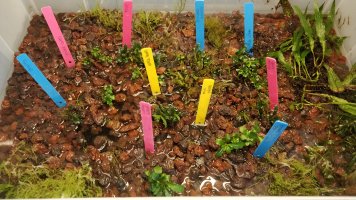J.C. Roozee
Seedling
After 6 months of no activity, I had the time to update a bit more on the current situation of the Bucephalandras (Buces) I have been keeping in a large storage box.
The box contains a 3 cm layer of "lava split" which is used for ground cover in gardens. The box is also filled with tap water (I believe dutch tap water is more than decent for the aquatic plant keeping hobby).
Over the last 12 months I did have the option to put small LED light on the box but as time progressed I observed that new leaves were forming with just daylight coming in so I kept it off for most of the time.
The first photo dates back to the start of November 2020. In general all rhizomes grew and some did better than others. I will describe the progress of each variant as organized from left to right in the box.
Overall, the larger leaved variants have performed better under these conditions. I could only speculate what the reason(s) are for these observations but I learned a couple of things from this experiment.
My goal was to propagate the plants to some extent so that I can use them for future projects or for reselling to others. The method I used is suitable for temporarily storing Buces but lacks the optimal conditions to
allow for plant growth, especially for the smaller variants mentioned here. In the coming months, I expect to start a new CO2-injected tank, where I will implement some of the Buce variants mentioned here.
This will involve weekly water changes of about 1/2 the tank volume where ample light, plant nutrition and water circulation are also included.
The box contains a 3 cm layer of "lava split" which is used for ground cover in gardens. The box is also filled with tap water (I believe dutch tap water is more than decent for the aquatic plant keeping hobby).
Over the last 12 months I did have the option to put small LED light on the box but as time progressed I observed that new leaves were forming with just daylight coming in so I kept it off for most of the time.
The first photo dates back to the start of November 2020. In general all rhizomes grew and some did better than others. I will describe the progress of each variant as organized from left to right in the box.
- Buce "Cherry" and "mini coin" (blue and pink on the left) melted almost completely but slowly recovered, with roughly 5 leaves emerging from the rhizome
- Buce "hades" (pink top site ) and "brownie blue" (blue topright) didn't melt in the beginning and has grown 1.5X in leave size and amount.
- Buce "red aphrodite" (blue bottom-right) and "wavy green" (pink center-bottom) did not melt and have grown consistently up to 2x in leave size and amount.
- Buce "Athena"(blue top label), "mini velvet" (yellow bottom center), "rainbow frost" (pink right side) and "angle tears" (yellow top center) didn't melt and have barely grown since last year.
Overall, the larger leaved variants have performed better under these conditions. I could only speculate what the reason(s) are for these observations but I learned a couple of things from this experiment.
- bucephalandras don't need much to stay alive, as long they are placed in a moist and stable environment at room temperature as many already have demonstrated.
- When placed in a emerged environment, it is more than likely that the plant will melt to some extent. By giving it a few months in the before mentioned environment it will slowly recover but don't expect miracles.
My goal was to propagate the plants to some extent so that I can use them for future projects or for reselling to others. The method I used is suitable for temporarily storing Buces but lacks the optimal conditions to
allow for plant growth, especially for the smaller variants mentioned here. In the coming months, I expect to start a new CO2-injected tank, where I will implement some of the Buce variants mentioned here.
This will involve weekly water changes of about 1/2 the tank volume where ample light, plant nutrition and water circulation are also included.



